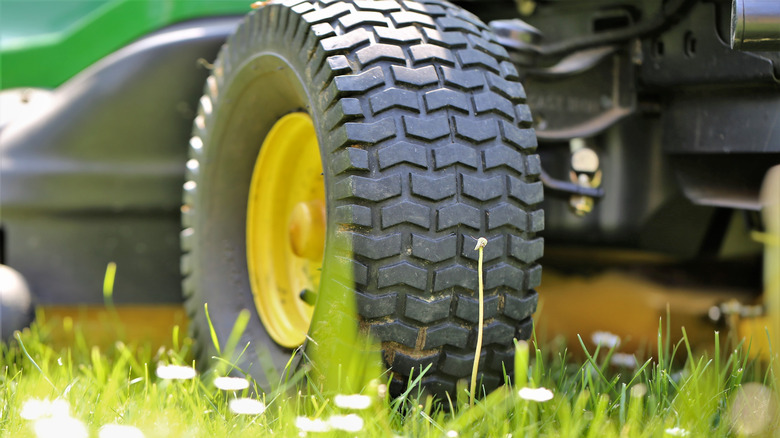Prevent Your Lawn Mower Tires From Going Flat With These Simple Tips
We may receive a commission on purchases made from links.
Small annoyances often show up when you're trying to do something productive. You can go through an entire week without a hiccup, but the moment you decide to mow the lawn — finally, responsibly, like the mature adult your life expects you to be — your mower greets you with a flat tire. This is when you realize life isn't always about big failures. Oftentimes, it's the minor nuisances that slow us down the most. But the good news is, it's not something out of your control. You can absolutely prevent flat tires by considering a few lawn mower safety tips, including scanning your lawn for sharp objects first, keeping the tires inflated to the right level, and giving your mower a safe, sheltered place to rest.
Mower tires often go flat because something very specific irritates them. The most common culprit here is jagged debris. Tiny branches snapping in storms or stray nails from a previous project, for example, could puncture the tire without you realizing it. Valve stems can be a problem, too. If they wear out or get damaged while you mow the lawn or fill your tire, they start to leak air little by little. Not to mention, prolonged exposure to direct sunlight will also weaken the tire's rubber, ultimately causing it to flatten.
Practical ways to help lawn mower tires hold air longer
Before you even pull that starter cord, do your mower a favor by taking a slow walk across your lawn. We know it looks clean, like nothing but grass and good intentions. But lawns hide stones just small enough to be dangerous and sticks sharp enough to behave like little knives. A quick scan and cleanup will go a long way toward giving your mower a safe path. Air pressure is another biggie. Too much pressure, and your tire becomes stiff, less able to absorb bumps, and more likely to crack. Too little, and it will squish under the mower's weight, putting unwanted stress on the sidewalls. Check the PSI markings on the tire, and stick to them when refilling.
While you're at it, give your tires a weekly check. Look for cuts and bulges, basically anything that makes your spider senses tingle. Inspections like these are also among the various lawn mower maintenance tasks you should be doing after every mow. If you want to be extra proactive, consider a tire sealant like LiquiTube Premium Tire Sealant. It coats the inside of the tire and seals small punctures instantly, helping protect against future issues.
Finally, your mower deserves better than being dumped outside like it's on timeout. High heat and UV exposure can dry out rubber, which eventually leads to cracks. To prevent lawn mower damage, place it in a dry garage or shed where the temperature stays relatively stable, keeping chemicals and gasoline away. If they drip onto your tires, they'll slowly eat into the rubber like termites on a wooden fence. Stay aware of the surrounding dangers, and you will be much less likely to find a flat holding you back from your lawn-mowing duties.

